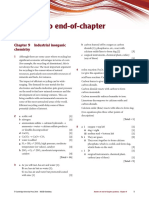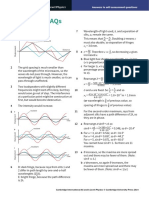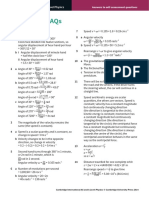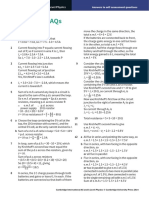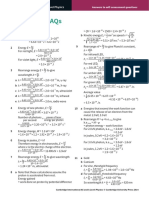Thermal Physics
Thermal Physics
Uploaded by
harshanauocCopyright:
Available Formats
Thermal Physics
Thermal Physics
Uploaded by
harshanauocOriginal Description:
Copyright
Available Formats
Share this document
Did you find this document useful?
Is this content inappropriate?
Copyright:
Available Formats
Thermal Physics
Thermal Physics
Uploaded by
harshanauocCopyright:
Available Formats
IGCSE Physics 0625 notes for topic 2: Thermal Physics: Revised on: 14 September 2010
TOPIC 2
THERMAL PHYSICS
THERMAL PHYSICS:
The branch of physics that study the temperature, heat energy and their relation to
the matter.
Temperature:
It is the degree of hotness of an object and it can be measured by thermometer.
Temperature can be express by Celsius (oC), Fahrenheit (oF) or K scale.
Heat:
It is the energy which travels from high temperature to low temperature in a matter.
It is also called thermal or internal energy. It is measured in joules (J).
MOLECULAR MODELS:
Matter is made up of atoms and molecules, which may only be seen by electronic
microscope.
Kinetic Molecular Theory of Matter:
The kinetic molecular theory explains the forces between molecules
and the energy that they possess. This theory has 3 basic assumptions.
1. Matter is made up of tiny small particles (atoms,
molecules or ions). The measure of volume of matter is
derived from the space in between the molecules and not
the space the molecules contain themselves.
2. The molecules are in constant motion (vibration, rotation or
translations). The motion of the molecules increases as they gain the
kinetic energy which is proportional to the temperature of the matter.
3. Heavier particles move more slowly than the lighter ones at a given
temperature.
a. In solids the molecules are closely packed together.
There is an attractive and repulsive force between
them, very similar to spring. The molecule vibrates
backward and forward about its fixed mean position.
Solids keep the definite volume and shape.
b. In liquids the molecules are slightly apart. They
vibrate backward and forward as well as move rapidly
over a short distance before they collide with each
other. Molecules that gain sufficient energy evaporate
Prepared by Faisal Jaffer: Emirates Private School, Al Ain
from liquid. Liquids have no definite shape but definite volume.
c. The molecules in gases are much farther
apart. The molecules move around with very high speed in all
directions and exert very little force on each other. Gases have
no definite shape and size.
4.
When the molecules collide with each other, or with the
walls of a container, there is no loss of energy.
STATES OF MATTER:
Objects that take up space and have mass are called matter. There are three states of
matter that is solids, liquids and gases. The properties of the particles are:
Solids
Liquids
Gases
Fixed shape, size and volume
No fixed shape but fixed
volume
No fixed shape, size or volume
vibrate about a fixed position
can flow; some movement
randomly around each other
can move freely and at random
at very high velocity in all space
available
particles are closely bound
particles loosely bound
particles are free to move
strong attractive and repulsive
force between them
weaker force of attraction
exert no force on each other
little expansion upon heating
slightly more expansion
upon heating
large expansion upon heating
little or no compression on
application of pressure
little or no compression on
application of pressure
much more compression upon
heating
Brownian motion:
Random movement of particle of liquids or gases is called Brownian motion. It was
discovered by Scottish Botanist Robert Brown in 1827. He observed that the fine
pollen grain on the surface of water are not stationary but moving about in a random
motion. This random motion of pollen grains caused by much smaller, invisible
faster moving water particles when they hit pollen grains from all direction. This
motion is called Brownian motion after the scientist who observed this phenomenon
for the first time.
IGCSE Physics 0625 notes for topic 2: Thermal Physics: Revised on: 14 September 2010
Evaporation, Boiling and Melting:
Evaporation
Boiling
Melting
Evaporation is the process of
converting liquid into vapours.
Boiling is the process of
converting liquid into vapours at
the boiling point.
Melting is the process of converting
solids into liquids
As a result of increasing the
temperature of liquid the
molecules start moving faster
and gain enough energy to break
the intermolecular bonding and
escape from the surface.
As a result of increasing the
temperature of liquid the
molecules start moving faster
and gain enough energy to break
the intermolecular bonding and
escape from the liquid.
As a result of increasing the
temperature of solid the molecules
start vibrating at faster rate and gain
enough energy to weaken the
intermolecular bonding.
It happens at any temperature.
It happens only at the boiling
point of the liquid.
It happens only at melting point of the
solid.
It happens at the liquid surface
only.
It happens anywhere within the
liquid.
It happens at the surface.
Average Ek decreases and
therefore the temperature of
liquid decreases
Average Ek stays the same and
therefore the temperature of
liquid does not increase
Average Ek stays the same while
melting and therefore the temperature
of solid does not increase
Bubbles not formed
Bubbles formed
No bubbles formed
The opposite of evaporation is
condensation by cooling
The opposite of boiling is
condensation by cooling
The opposite of melting is
solidification or freezing by cooling
EXPANSION OF SOLIDS AND LIQUIDS:
All matter expands when heated because of the increase in the vibration of the
molecules. Solids expand the least and liquid expand more than solid.
Examples of expansion from daily life are:
1) Shrink fitting of axles into gears wheels by cooling the axels in liquid
nitrogen at -196 oC (metal).
2) In kitchen tight metal lids can be opened from class jar by immersing
the lid in hot water so that it expands (metal).
3) Expansion of mercury in thermometer when measuring temperature
(liquid).
4) Water level rises behind the dam when the temperature of water
increases due the heat from the sun (liquid).
5) Gap between the railways tracks due to expansion in summer (metal).
6) Bimetallic strips: Strips of iron and copper or brass. Copper expands more
than the Iron. It is mostly used in fire alarm and thermostat (metal).
Prepared by Faisal Jaffer: Emirates Private School, Al Ain
Linear expansion of solids:
The linear expansivity of a substance is the increase in length of 1 meter for every
1oC. For example steel: 0.000012 /oC.
Expansion= linear expansivity original length change in temperature
or
L = Lo
L is change of length (L- Lo)
is linear expansivity
is change of temperature in oC (-o )
( means the different of two values)
Volume expansion of solids:
If the expansion of all three dimensions of a material is considered then:
Volume expansion = cubical expansivity original volume change in temperature
or
V = Vo
Temperature o
V is Change of Volume (V-Vo)
is Cubical expansivity
is Change of temperature (-o)
Temperature o+
For solids = 3
Cubic Expansivities examples
Solid (copper) = 0.00005/ oC
Liquid (water) = 0.0002/ oC
Gas
= 0.0037/ oC
TEMPERATURE, PRESSURE AND VOLUME OF GASES:
Unlike solids and liquids, a gas does not necessarily expand when heated.
This is because the volume is depend upon the container and therefore when
heated the collision of molecules with each other and with the walls of the
container increase and therefore the pressure increase, it the volume kept
constant.
The effect of pressure and temperature on gas:
1) Pressure of a gas is the force exerted by gas per unit area. It is the
measurement of the number of collisions of molecules with the walls of the
container.
IGCSE Physics 0625 notes for topic 2: Thermal Physics: Revised on: 14 September 2010
2) The velocity and the number of collisions of these molecules increase with
the increase of temperature that is increase in kinetic energy of molecules, if
the volume of the gas kept constant.
3) Lowering the pressure decreases its temperature.
The Gas Laws:
Charless law: volume temperature relationship at constant pressure
The volume of fixed mass of gas is directly proportional to its temperature if the
pressure is kept constant i.e.
Volume Temperature
(at constant pressure)
Pressure law: pressure-temperature relationship at constant volume
The pressure of the fixed mass of gas is directly proportional to its absolute
temperature if the volume kept constant.
Pressure Temperature
(at constant volume)
=
=
Boyles law: pressure - volume relationship at constant temperature
The pressure of fixed mass of gas is inversely proportional to its volume if its
temperature is kept constant.
=
=
General gas law:
pV
=constant or
T
In all Gas laws the temperature must be used in kelvin scale.
Absolute zero:
The lowest possible temperature is called absolute zero. It is -273oC or 0 K. At
absolute zero molecular motion of a substance is barely exists and it has no internal
energy which is against the laws of physics.
Prepared by Faisal Jaffer: Emirates Private School, Al Ain
T ( in kelvin scale) = 273+ ( in Celsius scale)
In physics the kelvin temperature is expressed by capital letter T and degree
Celsius is expressed by Greek symbol theta .
Expansion of water a special case:
The expansion of water is a special case. Unlike all matters the water
contracts when its temperature increases from 0oC to 4oC. Water has a
maximum density at 4oC. At 0oC when it freezes, a considerable volume
expansion occurs and for every 100cm3 of water it becomes 109 cm3 of ice.
This is why ice floats on the surface of water.
MEASUREMENT OF TEMPERATURE:
Volume of liquid is a physical property which varies with temperature. This property
of liquid may be used for the measurement of temperature. The daily life example is
thermometer. Two common liquids that are used in thermometers are
Mercury: It freezes at -39oC and boils at 357oC. It has low specific heat
capacity and it expands uniformly when heated. It doesnt stick to the glass.
Alcohol: It freezes at -115oC and boils at 78oC therefore it is suitable for low
range temperature. It is ideal for measuring atmospheric temperature. It
expands uniformly when heated. It is colored and therefore better visible.
Liquid in glass thermometer:
Fixed points in thermometer:
It was marked zero for the temperature when ice freezes and marked 100 when
water starts boiling. Then it was divided into 100 equal parts. It was invented by
Swedish scientist and named it Celsius. Both temperatures are measured at normal
pressure of 105 Pa (or N/m2).
Clinical Thermometer:
It is a special thermometer with scale at both sides of normal
body temperature. The special addition is the constriction that
breaks the mercury and we read the temperature. Normal body
temperature is 37oC.
Thermocouple Thermometer:
A thermocouple consists of wires of two different
materials e.g. copper and iron, joined together.
When one junction is at a higher temperature than
the other, an electric charge flows and produces a
current reading on a sensitive meter which
IGCSE Physics 0625 notes for topic 2: Thermal Physics: Revised on: 14 September 2010
depends on the temperature difference between the two junctions.
Thermocouples are used in industry to measure a wide range of temperatures from 250oC up to about 1500oC, especially rapidly changing ones and those of small
objects.
Linear scale: A scale in which the divisions are uniformly spaced.
SPECIFIC HEAT CAPACITY:
The Specific heat capacity of a substance is the amount of heat required to raise the
temperature by 1oC for the mass of 1 kg and is denoted by letter c. The unit of
specific heat capacity is J/(kg oC).
Example of 1 kg of water and 1 kg of paraffin (kerosene) would receive same
amount of heat energy for the same amount time but paraffin raises double the
temperature. Hence by definition:
Where c is the specific heat capacity, Q is the amount of heat energy in joules, m is
the mass of substance in grams or kilograms and is the change in temperature.
Specific heat capacity of water is very high compare to other substances. It is
4200J/(kg oC). It is useful in cooling car engines.
Thermal capacity:
The thermal capacity of a body is the quantity of heat needed to raise the
temperature of whole body by 1oC.
Thermal capacity = mass specific heat capacity
=mc
or
=
Internal energy:
Internal Energy is the energy stored in a system at the molecular level that is its
thermal energy. It is the kinetic energy of the atoms (or molecular) due to their
random motion plus the binding energy or electric potential energy that holds the
atoms (or molecular) together in terms of atomic bonds or intermolecular bond.
LATENT HEAT OF FUSION:
When a solid substance changes its state
from the solid to the liquid, energy must be
supplied in order to overcome the
molecular attractions between the particles
of the solid. This energy must be supplied
Prepared by Faisal Jaffer: Emirates Private School, Al Ain
externally, normally as heat, and does not change the temperature. We call this
energy latent heat (the word "latent" means "invisible"). It is the energy released or
absorbed during a change of state without increasing the temperature.
Specific latent heat of fusion:
"The specific latent heat of fusion (Lf) of a substance is the amount of heat energy
(Q) required to convert unit mass (m) of the solid into the liquid without a change in
temperature." Mathematically
=
LATENT HEAT OF
VAPORIZATION:
The change of state from
liquid to vapour at constant
temperature also requires the
input of energy, called the latent heat of vaporization. This implies that while a
liquid undergoes a change to the vapour state at the boiling point, the temperature of
the liquid will not rise beyond the temperature of the boiling point.
The latent heat of evaporation is the energy required to overcome the molecular
forces of attraction between the particles of a liquid in order to break their
intermolecular bonds, and bring them to the vapour state, where such attractions are
minimal.
Specific latent heat of vaporization:
'The specific latent heat of vaporization (Lv) is the amount of heat energy (Q)
required to convert unit mass (m) of a liquid into the vapour without a change in
temperature. Mathematically
Heating/cooling curves:
The diagram on the left shows the
uptake of heat energy by 1 kg of water,
as it passes from ice at -50 C to steam
at temperatures above 100 C, affects the
temperature of the sample.
A: Rise in temperature as ice absorbs
heat.
B: Absorption of latent heat of fusion.
C: Rise in temperature as liquid water
absorbs heat.
D: Water boils and absorbs latent heat
of vaporization.
IGCSE Physics 0625 notes for topic 2: Thermal Physics: Revised on: 14 September 2010
E: Steam absorbs heat and thus increases its temperature.
The above is an example of a heating curve. One could reverse the process, and
obtain a cooling curve. The flat portions of such curves indicate the phase changes.
TRANSFER OF THERMAL ENERGY OR HEAT
ENERGY:
The transfer of heat energy normally occurs from higher temperature to
lower temperature. Heat transfer changes the internal energy of both
systems involved. There are three ways that heat can transfer in matter.
That is conduction, convection and radiation.
Conduction:
Conduction always occurs in solids. It is the heat
transfer by means of faster molecular motion within a
material without any shift of the material as a whole. If
one end of a metal rod is at a higher temperature, then
energy will be transferred towards the colder end
because the higher speed particles will collide with the slower ones with a net
transfer of energy to the slower ones. All metal
substances are good conductors.
Convection:
Convection is heat transfer by the motion of
fluid such as air or water when the heated fluid
is caused to move away from the source of heat,
carrying energy with it. Convection above a hot
surface occurs because hot air expands, becomes
less dense, and rises. Hot water is less dense
than cold water and rises, causing convection
currents which transfer energy.
Radiation:
Radiation is the heat transfer
without the presence of any
medium that is it can occur in
vacuum. Radiation is the flow
of heat from one place to
another by means of
electromagnetic waves.
Prepared by Faisal Jaffer: Emirates Private School, Al Ain
10
Good and bad absorbers and emitters:
All bodies emit or absorb radiation mostly of infrared type. However
a) Dull black surfaces are better absorbers of radiation than white and shiny
surfaces.
b) Dull black surfaces are better emitter of radiation than the shiny one.
CONDENSATION AND SOLIDIFICATION:
Condensation is the opposite of evaporation. It is the process of changing vapours
into liquid by decreasing the temperature. For example the formation water droplets
at the outer surface of colder water container or formation of clouds.
Freezing or solidification is the process in which liquid turns into a solid when
temperature decreases enough. The freezing point is the temperature at which this
happens. Melting, the process of turning solid into liquid is almost the exact opposite
of freezing. All liquids undergo freezing when the temperature is lowered enough,
with the sole exception of liquid helium, which remains liquid at absolute zero and
can only be solidified under pressure. For most substances, the melting and freezing
points are the same temperature.
Practice question from book:
Book: IGCSE Physics by Tom Duncan:
1.
2.
3.
4.
5.
6.
7.
8.
Brownian motion, molecular theory: page no 125 Q1 and Q2
Thermometers: page no 128, Q1 to Q4
Expansion: page no 132, Q1
The gas laws: page nos. 137 and 138 Q1 to Q4
Specific heat capacity: page no 141 Q1 to 4
Specific latent heat: page 146 and 147 Q1 to Q11
Conduction convection and radiation: page 152, 155 all questions
Additional questions: page no 156, 157 and 158 all questions
You might also like
- As Level Physics Formula SheetDocument19 pagesAs Level Physics Formula SheetIsiaka AbibuNo ratings yet
- Worksheet Born-Haber Cycle Answer Key PDFDocument3 pagesWorksheet Born-Haber Cycle Answer Key PDFBrandeice BarrettNo ratings yet
- IGCSE Forces and Motion Definitions and ConceptsDocument6 pagesIGCSE Forces and Motion Definitions and ConceptsLavanya TheviNo ratings yet
- O Level Chemistry Organic Practice QuestionDocument2 pagesO Level Chemistry Organic Practice QuestionMINGHUI86No ratings yet
- L A Level Biology MS Jan 05Document180 pagesL A Level Biology MS Jan 05annakaranovaNo ratings yet
- Class 9 Structure of Atom-MCQDocument1 pageClass 9 Structure of Atom-MCQbrcrao100% (2)
- GEOMETERY Bearing NAME: CLASS: 10 DATE: .. Bearing Is An Angle That States The Direction of One Position From Another. Compass DirectionDocument2 pagesGEOMETERY Bearing NAME: CLASS: 10 DATE: .. Bearing Is An Angle That States The Direction of One Position From Another. Compass DirectionYOONG CHUAN LOONGNo ratings yet
- Revision Notes PDFDocument7 pagesRevision Notes PDFrafeekherNo ratings yet
- Level Past Paper Questions - Physics O: TOPIC-22 Electronics PAPER-1 Multiple ChoiceDocument10 pagesLevel Past Paper Questions - Physics O: TOPIC-22 Electronics PAPER-1 Multiple Choiceelty TanNo ratings yet
- Learner Guide For O Level PhysicsDocument33 pagesLearner Guide For O Level PhysicsArslan FarooqNo ratings yet
- Physics 9 O Level TestDocument4 pagesPhysics 9 O Level TestAllam S/o Mumtaz Ali TunioNo ratings yet
- Electrolysis O LevelDocument17 pagesElectrolysis O LevelInnocent Ebil100% (1)
- 0625 w11 Ms 11Document2 pages0625 w11 Ms 11Shrungar BhuvaNo ratings yet
- Activity 17 (Preparation of Salts)Document4 pagesActivity 17 (Preparation of Salts)Nkemzi Elias NzetengenleNo ratings yet
- ODU Mechanics Questions o Level A Level PhysicsDocument40 pagesODU Mechanics Questions o Level A Level Physicsduncon100% (1)
- Transition Metals Part 1 EdexcelDocument5 pagesTransition Metals Part 1 EdexcelKevin The Chemistry TutorNo ratings yet
- The Ultimate IGCSE Physics GuideDocument40 pagesThe Ultimate IGCSE Physics GuidePeter KachouhNo ratings yet
- O-Level Physics - Current ElectricityDocument2 pagesO-Level Physics - Current ElectricityGolam Hasib100% (1)
- Magnetic Effects of Electric CurrentDocument4 pagesMagnetic Effects of Electric CurrentXxxxxxNo ratings yet
- O' Levels Revision Guide - Physics ATP NotesDocument11 pagesO' Levels Revision Guide - Physics ATP NotesAreeb0% (2)
- Answers To End-Of-Chapter Questions: Chapter 9 Industrial Inorganic ChemistryDocument2 pagesAnswers To End-Of-Chapter Questions: Chapter 9 Industrial Inorganic ChemistryMP3 MusicNo ratings yet
- Physics Topical QuestionDocument1 pagePhysics Topical QuestionKavitha BalakrishnanNo ratings yet
- Chapter 9 Industrial Inorganic Chemistry 9 1 and 9 2Document25 pagesChapter 9 Industrial Inorganic Chemistry 9 1 and 9 2api-31398777767% (6)
- O Level SC (Physics) v2.0: General Notes and Definitions For Instant RevisionDocument12 pagesO Level SC (Physics) v2.0: General Notes and Definitions For Instant RevisionMuhammad Afzal Saroya100% (1)
- JFS Physics Notes Complete A-LevelDocument60 pagesJFS Physics Notes Complete A-Levelyudipurwanto0% (1)
- Cambridge International AS & A Level: PHYSICS 9702/22Document16 pagesCambridge International AS & A Level: PHYSICS 9702/22Noor MuhammadNo ratings yet
- Letter Writing Example 1Document2 pagesLetter Writing Example 1Arul Gaspar100% (1)
- O Level Physics NotesDocument6 pagesO Level Physics NotesHamza Kahemela86% (7)
- Alternative To Practical Questions IGCSEset 1Document15 pagesAlternative To Practical Questions IGCSEset 1danielphilip68100% (2)
- Worksheet - Moment (1) SolvedDocument9 pagesWorksheet - Moment (1) SolvedSyed ShahNo ratings yet
- Physics P1 Topical Past Papers-Selected-249-294Document47 pagesPhysics P1 Topical Past Papers-Selected-249-294Riaz KhanNo ratings yet
- 9th Class ElectrochemistryDocument18 pages9th Class ElectrochemistryCh NajamNo ratings yet
- O Level Physics ATP ReferencesDocument4 pagesO Level Physics ATP ReferencesHassan Ali BhuttaNo ratings yet
- FlotationDocument14 pagesFlotationAbhinav BajpaiNo ratings yet
- Physics Revision ChecklistDocument36 pagesPhysics Revision Checklistapi-3723991100% (5)
- Scheme of Work: Cambridge O Level Chemistry 5070Document55 pagesScheme of Work: Cambridge O Level Chemistry 5070Syed Ashar50% (2)
- Laws of IndicesDocument4 pagesLaws of IndicesstephenidahNo ratings yet
- Heat Notes A LevelDocument47 pagesHeat Notes A LevelEd Molson100% (1)
- A Level Notes On Transition MetalsDocument18 pagesA Level Notes On Transition Metalskmoiz427No ratings yet
- Revision Summary Sheets For IGCSE Physical ScienceDocument9 pagesRevision Summary Sheets For IGCSE Physical ScienceMohamed Zein HendawyNo ratings yet
- Chemistry Chemical Equation and ReactionDocument7 pagesChemistry Chemical Equation and Reactionsmriti khannaNo ratings yet
- Notes Physics Mass, Weight, DensityDocument7 pagesNotes Physics Mass, Weight, DensitySalmanNo ratings yet
- Notes Igcse PhysicsDocument8 pagesNotes Igcse PhysicsLugya OmarNo ratings yet
- O level Physics Questions And Answer Practice Papers 3From EverandO level Physics Questions And Answer Practice Papers 3Rating: 3 out of 5 stars3/5 (1)
- O level Physics Questions And Answer Practice Papers 1From EverandO level Physics Questions And Answer Practice Papers 1Rating: 3.5 out of 5 stars3.5/5 (4)
- O level Physics Questions And Answer Practice Papers 2From EverandO level Physics Questions And Answer Practice Papers 2Rating: 5 out of 5 stars5/5 (1)
- Topical Guidebook For GCE O Level Biology 3 Part 2From EverandTopical Guidebook For GCE O Level Biology 3 Part 2Rating: 5 out of 5 stars5/5 (1)
- Answers To Saqs: Cambridge International As Level PhysicsDocument2 pagesAnswers To Saqs: Cambridge International As Level Physicsharshanauoc100% (1)
- Harshana Perera (B.SC - BIT, SCJP) 2016 Paper 1Document15 pagesHarshana Perera (B.SC - BIT, SCJP) 2016 Paper 1harshanauocNo ratings yet
- Answers To Saqs: Cambridge International A Level PhysicsDocument2 pagesAnswers To Saqs: Cambridge International A Level Physicsharshanauoc100% (1)
- Answers To Saqs: Cambridge International A Level PhysicsDocument2 pagesAnswers To Saqs: Cambridge International A Level Physicsharshanauoc100% (1)
- Answers To Saqs: Cambridge International As Level PhysicsDocument2 pagesAnswers To Saqs: Cambridge International As Level Physicsharshanauoc100% (3)
- Answers To Saqs: Cambridge International As Level PhysicsDocument2 pagesAnswers To Saqs: Cambridge International As Level PhysicsharshanauocNo ratings yet
- EOCQ Ans 19Document2 pagesEOCQ Ans 19harshanauocNo ratings yet
- Answers To Saqs: Cambridge International As Level PhysicsDocument2 pagesAnswers To Saqs: Cambridge International As Level PhysicsharshanauocNo ratings yet
- Answers To EOC Questions: Cambridge International A Level PhysicsDocument2 pagesAnswers To EOC Questions: Cambridge International A Level PhysicsharshanauocNo ratings yet
- SAQ Ans 28Document2 pagesSAQ Ans 28harshanauocNo ratings yet
- Answers To Saqs: Cambridge International A Level PhysicsDocument1 pageAnswers To Saqs: Cambridge International A Level PhysicsharshanauocNo ratings yet
- Answers To Saqs: Cambridge International A Level PhysicsDocument2 pagesAnswers To Saqs: Cambridge International A Level PhysicsharshanauocNo ratings yet
- Answers To Saqs: Cambridge International As Level PhysicsDocument2 pagesAnswers To Saqs: Cambridge International As Level Physicsharshanauoc100% (1)
- SAQ Ans 10Document2 pagesSAQ Ans 10harshanauoc0% (1)
- SAQ Ans 24Document2 pagesSAQ Ans 24harshanauocNo ratings yet
- SAQ Ans 7Document2 pagesSAQ Ans 7harshanauocNo ratings yet
- SAQ Ans 30Document2 pagesSAQ Ans 30harshanauocNo ratings yet
- SAQ Ans 10Document2 pagesSAQ Ans 10harshanauoc0% (1)
- SAQ Ans 8Document1 pageSAQ Ans 8harshanauocNo ratings yet
- SAQ Ans 6Document3 pagesSAQ Ans 6harshanauocNo ratings yet
- EOCQ Ans 21Document2 pagesEOCQ Ans 21harshanauocNo ratings yet
- Answers To EOC Questions: Cambridge International A Level PhysicsDocument2 pagesAnswers To EOC Questions: Cambridge International A Level PhysicsharshanauocNo ratings yet
- HPLC Column c18 With Mobile Phase For Succinylsulfathizaole PG 18Document36 pagesHPLC Column c18 With Mobile Phase For Succinylsulfathizaole PG 18khanNo ratings yet
- Durablue d25Document184 pagesDurablue d25arturoNo ratings yet
- APA Citation Guide & Reference List: FSUU Learning Resource Center (Fsuulrc) by Jane P. Singuran, MSLISDocument44 pagesAPA Citation Guide & Reference List: FSUU Learning Resource Center (Fsuulrc) by Jane P. Singuran, MSLISMcDonz AmbonganNo ratings yet
- Edinet Communicator Comprehensive B2B Integration ServicesDocument7 pagesEdinet Communicator Comprehensive B2B Integration ServicesMirela CojocNo ratings yet
- CSE-NBA Book Formate C4 - 07 Feb 2019Document27 pagesCSE-NBA Book Formate C4 - 07 Feb 2019devender0% (1)
- 100 Vocabulary Words 9TH GRADEDocument17 pages100 Vocabulary Words 9TH GRADEKarla RodriguezNo ratings yet
- Criteria For Most Outstanding TeacherDocument20 pagesCriteria For Most Outstanding TeacherJake Bautista100% (8)
- Merchandise Assortment Planning of Various Retail Counters Ta JalandharDocument81 pagesMerchandise Assortment Planning of Various Retail Counters Ta JalandharTajinder Pal Saini75% (4)
- Raphael Nkwabi Vs Naomi Lucas Mbuki (Consolidated Civil Appeals No 95 113 of 2021) 2024 TZCA 572 (17 July 2024)Document8 pagesRaphael Nkwabi Vs Naomi Lucas Mbuki (Consolidated Civil Appeals No 95 113 of 2021) 2024 TZCA 572 (17 July 2024)clarenceNo ratings yet
- School NurseDocument4 pagesSchool NurseJe Sie100% (2)
- Choose The Correct Answer.: Vocabulary, Unit 1Document9 pagesChoose The Correct Answer.: Vocabulary, Unit 1Katy GallagherNo ratings yet
- Design, Delivery and Evaluation of Training (Training Cycle)Document35 pagesDesign, Delivery and Evaluation of Training (Training Cycle)Iliciuc SergheiNo ratings yet
- Do Global Stocks Outperform US Treasury Bills? Hendrik Bessembinder Et Al July 5, 2019Document85 pagesDo Global Stocks Outperform US Treasury Bills? Hendrik Bessembinder Et Al July 5, 2019Abdullah18No ratings yet
- Woocommerce All Discounts: User ManualDocument15 pagesWoocommerce All Discounts: User ManualFrank QuitianNo ratings yet
- Nutrient Limitation of Tree Seedling Growth in Three Soil Types Found in SabahDocument10 pagesNutrient Limitation of Tree Seedling Growth in Three Soil Types Found in SabahRudin RilbanNo ratings yet
- Ambix 1 - Issue 1.4Document13 pagesAmbix 1 - Issue 1.4Diogo CalazansNo ratings yet
- CASE Allergic RhinitisDocument5 pagesCASE Allergic Rhinitisrizgah jawas100% (1)
- Radiology EssentialsDocument308 pagesRadiology EssentialsDeborah Anasthasia PakpahanNo ratings yet
- Mathematics Standard Level Paper 1: Instructions To CandidatesDocument12 pagesMathematics Standard Level Paper 1: Instructions To CandidatesKashvi SharmaNo ratings yet
- Básico 1 - Lesson 3 - Verb To BeDocument11 pagesBásico 1 - Lesson 3 - Verb To BeLeonardo SilvaNo ratings yet
- Descriptive Stat1Document24 pagesDescriptive Stat1Zia AhmadNo ratings yet
- Discrete Mathematics: (ONLY Textbook I Allowed. No Notes or Cheat Sheet Is Allowed.)Document6 pagesDiscrete Mathematics: (ONLY Textbook I Allowed. No Notes or Cheat Sheet Is Allowed.)Muhammad AbdullahNo ratings yet
- Lumen GentiumDocument28 pagesLumen GentiumEmma AnakwubaNo ratings yet
- The Character of A Happy Life by Sir Henry Wotton - Aral NoteDocument1 pageThe Character of A Happy Life by Sir Henry Wotton - Aral Noteayomiposi 2712No ratings yet
- Badger PDFDocument226 pagesBadger PDFRIZKA WILDANINo ratings yet
- Uncommon Service: How To Win by Putting Customers at The Core of Your BusinessDocument80 pagesUncommon Service: How To Win by Putting Customers at The Core of Your BusinessriefkurNo ratings yet
- Accounting Seminar 1 (Topic)Document20 pagesAccounting Seminar 1 (Topic)Kusnadi Nawawinata100% (1)
- Limiting FactorDocument4 pagesLimiting FactorGaurav JadhavNo ratings yet
- Current Scenario of SME in BangladeshDocument16 pagesCurrent Scenario of SME in BangladeshAshiqul Islam100% (2)
- The Moon that Embraces the Sun 1 (달달 달달 달 #1) : by Jung Eun-gwolDocument5 pagesThe Moon that Embraces the Sun 1 (달달 달달 달 #1) : by Jung Eun-gwolBintang David SusantoNo ratings yet




















